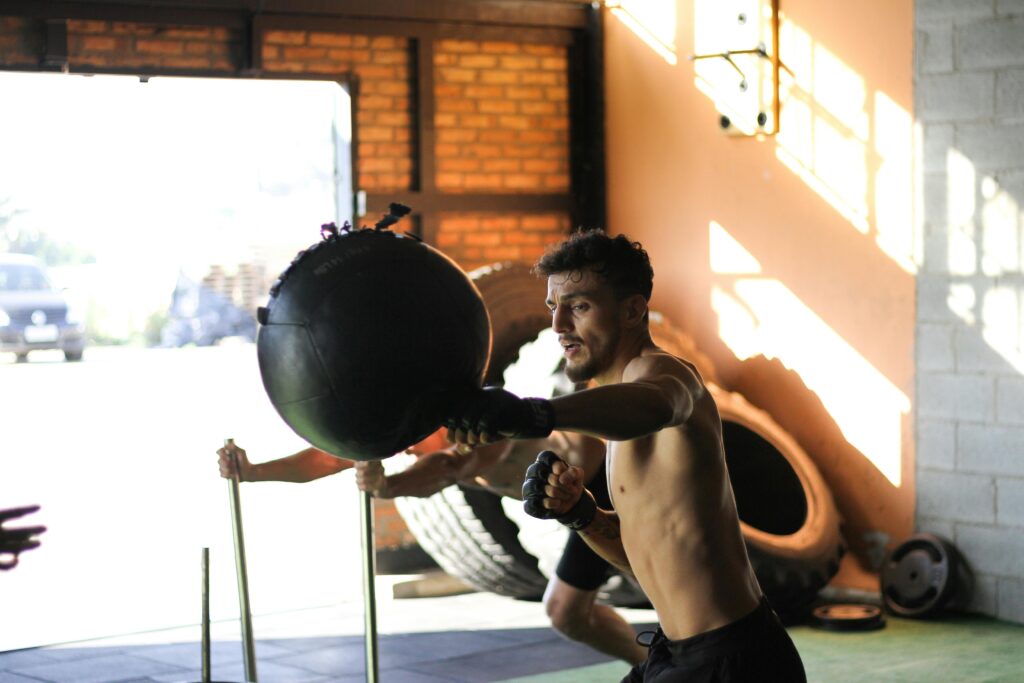
Here’s part 2 of the Specificity of conditioning for MMA series by Danny Hague where he explores ways to meeting the energy demands of the sport and also provides an excellent strength and conditioning circuit for MMA fighters. Here’s part one in case you missed it:
Specificity of conditioning for MMA part 1
Strength and Conditioning For Mixed Martial Arts Part 2
The Aerobic system regenerates ATP through oxidative means (with oxygen) and can produce the most amounts of ATP, however this process is a lot slower than the anaerobic systems as there are many more chemical steps to take to regenerate ATP aerobically. So the aerobic system is capable of sustaining moderate power outputs for very long durations.
So to summarise the body is always striving for energy homeostasis within the working muscles and it has the ability to regenerate ATP either at tremendously high rates (anaerobically) for short periods of time, or at more moderate levels (aerobically) for an incredible amount of time. What people may not realise and science has come to now show us, is that all three energy systems are essentially ‘turned on’ from the very beginning of exercise. They don’t activate in sequence and are constantly overlapping to provide ATP to the working muscles to perform mechanical work for the specific activity. The Aerobic system is still heavily involved even at the highest anaerobic intensities and newer research states that even very short high intensity efforts lasting as short as 1 minute, almost 50% of total energy production can come from the aerobic system.
From the information above you can see that a fighter requires high levels of both anaerobic and aerobic conditioning to meet the high intermittent nature of MMA. They need high levels of anaerobic development to meet the high power/force outputs involved in striking, takedowns, clinching and wrestling, and a well developed aerobic system to help refuel these explosive efforts over and over for the course of the rounds, as well as helping to rid the body of the by products such as hydrogen ions.
Meeting the energy demands of the sport
Taking all of this into consideration with regards to meeting the energy demands of the sport, long steady distance training is not the way to go if you want to be in fighting shape. As the sport of MMA is intermittent in nature, high intensity intervals are a much more sensible approach to take. So the use of sprints, hill sprints, sled dragging, and metabolic circuits are great options and I use these with my fighters further out from their fights to develop higher levels of relative work capacity. However for the conditioning program to ensure maximum transfer, again the ‘Specificity principle’ must be addressed. See the cardiovascular system does not work in isolation, in fact it works synergistically with the rest of the bodies processes. It is the muscles themselves producing force for mechanical work that determines the energy requirements from the cardiovascular system. So you must take into account the interaction between the neuromuscular, cardiovascular, metabolic, and hormonal systems. You must take into account that fatigue manifests itself centrally (systemically), and locally (peripheral). Sprints and the like are great for systemic conditioning but what about the local muscular fatigue that accumulates in the shoulders and arms for repeated explosive punching, or if you are tied up with your opponent in and isometric hold?
The approach I use is to look at the kinematics (movement patterns), and kinetics (force profiles) of the sport (MMA) as well as the work dynamics (work/rest), and in conjunction with the fighters particular game plan, set up a fight simulation circuit containing non specific exercises to overload key musculature and specific exercises to make sure technique, skill and decision making are all trained under high levels of fatigue. The above approach I believe is what will ensure optimal transfer into the ring or cage.
MMA strength and conditioning circuit
Below is an example circuit for the conditioning phase, I have recently used with one of my fighters to prepare him for a title fight of 3, 5 minute rounds. The goal throughout the weeks was to reduce the time it takes him to complete the rounds, to improve power output, while simultaneously reducing his rest periods week to week:
- Airdyne bike (30secs)
- Dumbbell Matrix (180 reps, pre-fatigue punching musculature)
- Specific Pad Work (30 secs)
- Crash Mat Sprawls (20 reps)
- Recline Rope Pulls (20 reps)
- Med Ball Slams (10 reps)
- Sumo Deadlifts (10 reps, fight weight + 10%)
- Sprawl and Tackle Bag Hit (5 each side)
- Specific Pad Work (30secs)
Strength and conditioning program for MMA
So there you go guys that was the specific fight circuit I used, it mimics the movement patterns, and force outputs you will experience in a fight. I believe this is the most sensible approach to take to condition a fighter for competition. This method takes into consideration the ‘Specificity Principle’ and I think will ensure training will transfer into the cage. Not only does it condition the body for competition it is less abusive than heavy sparring all the time, which will reduce the risk of injury and help prolong fighters careers. Please take into account that this is the conditioning side of the equation, fighters need to make sure these sessions are put into a well developed systematic strength and conditioning program for MMA that works with the development of all the physical qualities needed, such as maximal strength, specific strength, power, and ballistic strength. Any way let me know what you all think feedback would be much appreciated, cheers.
Danny Hague ASCC, MMA-CSCC